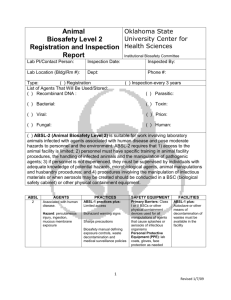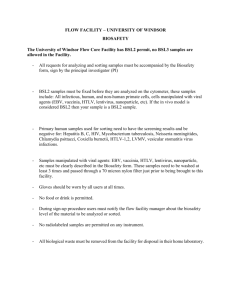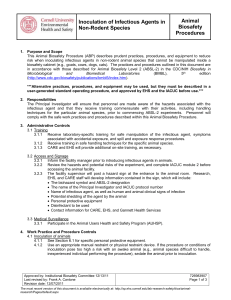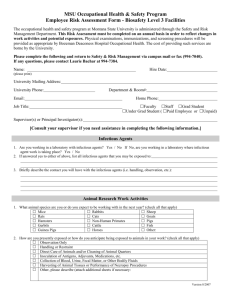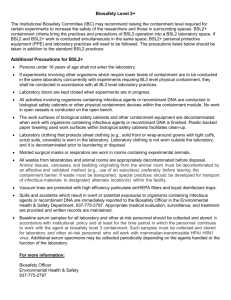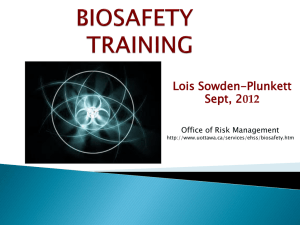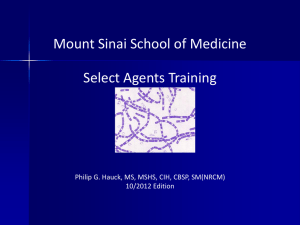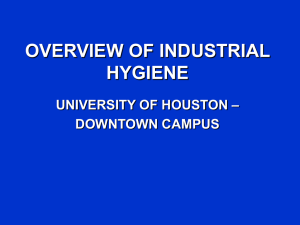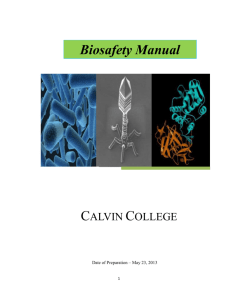BSL2 inspection chec..
advertisement
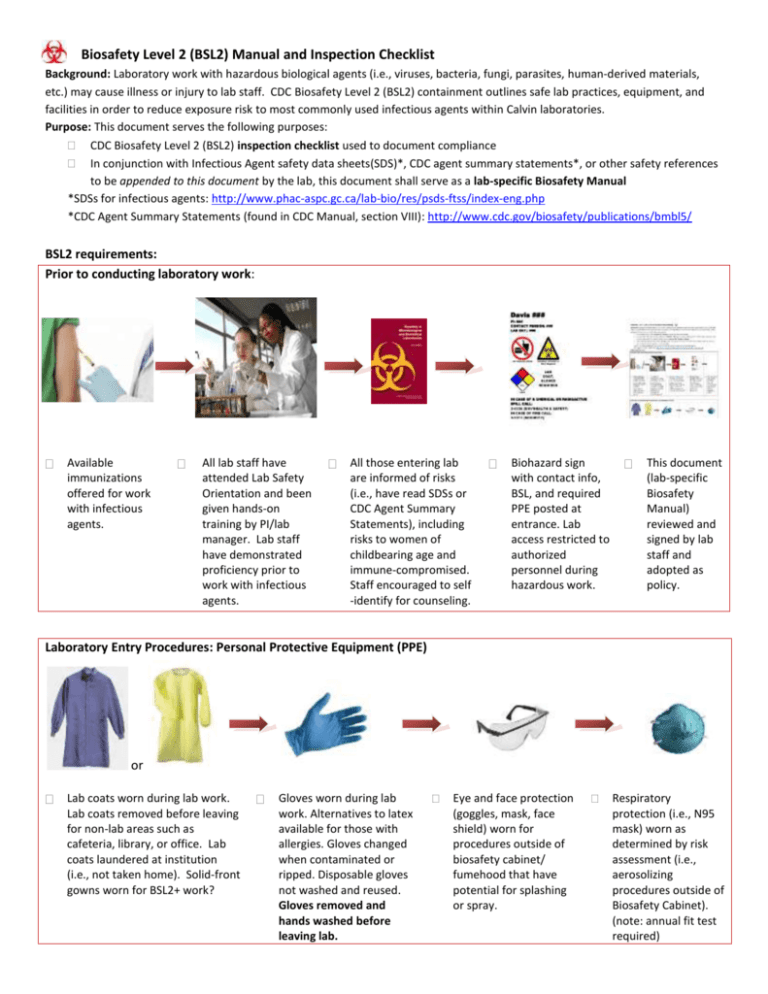
Biosafety Level 2 (BSL2) Manual and Inspection Checklist Background: Laboratory work with hazardous biological agents (i.e., viruses, bacteria, fungi, parasites, human-derived materials, etc.) may cause illness or injury to lab staff. CDC Biosafety Level 2 (BSL2) containment outlines safe lab practices, equipment, and facilities in order to reduce exposure risk to most commonly used infectious agents within Calvin laboratories. Purpose: This document serves the following purposes: CDC Biosafety Level 2 (BSL2) inspection checklist used to document compliance In conjunction with Infectious Agent safety data sheets(SDS)*, CDC agent summary statements*, or other safety references to be appended to this document by the lab, this document shall serve as a lab-specific Biosafety Manual *SDSs for infectious agents: http://www.phac-aspc.gc.ca/lab-bio/res/psds-ftss/index-eng.php *CDC Agent Summary Statements (found in CDC Manual, section VIII): http://www.cdc.gov/biosafety/publications/bmbl5/ BSL2 requirements: Prior to conducting laboratory work: Available immunizations offered for work with infectious agents. All lab staff have attended Lab Safety Orientation and been given hands-on training by PI/lab manager. Lab staff have demonstrated proficiency prior to work with infectious agents. All those entering lab are informed of risks (i.e., have read SDSs or CDC Agent Summary Statements), including risks to women of childbearing age and immune-compromised. Staff encouraged to self -identify for counseling. Biohazard sign with contact info, BSL, and required PPE posted at entrance. Lab access restricted to authorized personnel during hazardous work. This document (lab-specific Biosafety Manual) reviewed and signed by lab staff and adopted as policy. Laboratory Entry Procedures: Personal Protective Equipment (PPE) or Lab coats worn during lab work. Lab coats removed before leaving for non-lab areas such as cafeteria, library, or office. Lab coats laundered at institution (i.e., not taken home). Solid-front gowns worn for BSL2+ work? Gloves worn during lab work. Alternatives to latex available for those with allergies. Gloves changed when contaminated or ripped. Disposable gloves not washed and reused. Gloves removed and hands washed before leaving lab. Eye and face protection (goggles, mask, face shield) worn for procedures outside of biosafety cabinet/ fumehood that have potential for splashing or spray. Respiratory protection (i.e., N95 mask) worn as determined by risk assessment (i.e., aerosolizing procedures outside of Biosafety Cabinet). (note: annual fit test required) Prohibited Laboratory Practices No eating, drinking, smoking, handling contact lenses, applying cosmetics, or storing food in lab areas. No open-toed shoes. No sniffing in vitro cultures or mouth pipetting. No non-research plants or animals in lab. No carpets, rugs, or fabriccovered chairs in lab. Safe Laboratory Practices: Sharps Safety (needles, scalpels, Pasteur pipets, broken glassware) Celltreat® Plasteur™ Plastic Pasteur Pipets Needles not bent, sheared, broken, recapped, or removed from syringes by hand before disposal. Non-disposable sharps (i.e., scissors) transported for disinfection (i.e., autoclave) within secondary container. Safetyengineered needles or scalpels (i.e., shielded) used where possible. Animals anesthetized or restrained during injection procedures. Plastic substituted for glass (i.e., Pasteur pipettes) wherever possible? Direct handling of broken glassware prohibited (i.e., brush and dustpan used). Used sharps placed immediately after use into conveniently located sharps container. Sharps lid not removed. Sharps container not overfilled. Safe Laboratory Practices: Aerosol/Splash Containment vacuum flasks filled to 10% (v/v) bleach Vacu-guard in-line filter Procedures performed carefully to minimize splashing and aerosols (i.e., pipet fluids down wall of container). Certified Biosafety Cabinet (BSC) used for high concentrations/large volumes of infectious agents or aerosol producing procedures such as grinding, blending, vortexing, etc. For BSL2+ work, all open manipulations of infectious agents conducted within BSC. Vacuum lines protected with liquid disinfectant trap/flask. In-line filter used to protect vacuum line from aerosols/ droplets. Sealed rotor, centrifuge safety cups, or other containment (i.e., Biosafety cabinet) used for centrifuge of infectious materials. Safe Laboratory Practices: Cleanup, Disposal, and Exit Procedures Work surfaces routinely decontaminated with suitable disinfectant such as 10% bleach after work and any spills. Liquid biological wastes (i.e., media) disinfected (i.e., final volume 10% bleach) before disposal. Lab equipment (i.e., centrifuge) routinely decontaminated and also before repair, maintenance, or removal from lab. Potentially infectious waste (i.e. plates, tubes, contaminated PPE, etc.) placed into red-bag lined biohazard container. Sharps waste placed into sharps disposal containers. Infectious materials placed in durable leak proof containers during collection, handling, processing, storage, or transport (i.e., sealable secondary container used for transport). PPE such as gloves and lab coat removed upon exiting lab. Personnel wash hands after work with hazardous materials, after removing gloves, and before leaving lab. Emergency Procedures: Accidental Spills and Personnel Contamination/Exposure Accidental spill procedure: Notify Safety Office for assistance (x34336) Cleanup may be conducted only by staff trained and equipped to work with infectious material Remove contaminated clothing/PPE Notify others around you and restrict access to area; if aerosol, leave room for 20 min. to allow aerosols to settle Don lab coat, gloves, and safety glasses Use forceps or other mechanical device to remove any broken glass; place into sharps container Cover spill with paper towels or other absorbent materials and saturate with 10% bleach Allow 15 min. contact time then wipe from perimeter working inwards towards center Dispose of materials as biohazardous waste Personnel contamination/exposure procedure: Remove any contaminated clothing/PPE Wash all affected areas; for eye exposures, rinse 15 min. in eyewash or flush area with water; for needle-stick or other exposures wash wound area with soap and water 15 min. Report exposure to supervisor immediately Complete Employee Accident Report Seek medical evaluation and treatment ASAP: Environmental Health & Safety Emergency Department (after (8am-4:30pm) hours) Heather Chapman Med-1 Leonard Physical Plant, 107 1140 Monroe, Ste 150 Telephone: x6-8591 Grand Rapids, MI Cell: 734.776.6970 616.459.6331 Additional Safety Requirements for the laboratory (as determined by risk assessment): BSL2 LAB FACILITY Biohazard sign posted at entrance including BSL, contact info, and PPE requirements? Windows that open fitted with fly screen? Biosafety cabinet installed away from door, certified annually, used for aerosol producing procedures? Eyewash available? Lab furniture appropriate for loading and use; benchtop resistant to chemicals? Autoclave or other method for disinfection (i.e., bleach) available? No carpets, rugs, or fabric covered chairs? Area cleanable? Self closing doors; Lab access restricted (doors locked when unoccupied)? Hand washing sink with soap and paper towels? Inward flow of air? (recommended) No plants or nonresearch animals; insect/pest control maintained? Principal Investigator and Lab Staff Assurances NOTE: Append to this document any Infectious Agent SDSs, CDC Agent Summary Statements, or other references describing hazards of biological agents used in the laboratory. SDSs for infectious agents: http://www.phac-aspc.gc.ca/lab-bio/res/psds-ftss/index-eng.php CDC Agent Summary Statements (found in section VIII): http://www.cdc.gov/biosafety/publications/bmbl5/ Principal Investigator By signing below, you acknowledge responsibility for the following: Being adequately trained in good microbiological techniques Enforcing institutional policies to restrict access to the laboratory Ensuring lab staff attend required Laboratory/Radiation Safety Orientation through Environmental Health & Safety Ensuring lab staff have been trained by the PI/lab manager regarding their duties, the necessary precautions to prevent exposures, and exposure evaluation procedures Ensuring lab personnel, particularly women of childbearing age, have been provided with information by the PI/lab manager regarding immune competence and conditions that may predispose them to infection Ensuring lab staff demonstrate proficiency in safety practices described in this manual prior to work with infectious agents Correcting any unsafe working conditions _____________________________ PI Name (printed) _______________________ Signature ________ Date Lab personnel By signing below, you acknowledge responsibility for the following: Participating in required Laboratory Safety Orientation offered online by Environmental Health & Safety Reading and abiding by this Biosafety Manual/Inspection document and any applicable SDSs/CDC agent summary statements Understanding and monitoring for signs and symptoms of exposure to infectious agents used in the lab and immediately reporting any suspected exposures, injuries, or illnesses from the lab _____________________________ Name (printed) _______________________ Signature ________ Date _____________________________ Name (printed) _______________________ Signature ________ Date _____________________________ Name (printed) _______________________ Signature ________ Date _____________________________ Name (printed) _______________________ Signature ________ Date _____________________________ Name (printed) _______________________ Signature ________ Date _____________________________ Name (printed) _______________________ Signature ________ Date _____________________________ Name (printed) _______________________ Signature ________ Date
